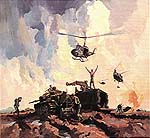
A Tale of Two Meteors: The Repetitive Lifecycle of a Tank Engine
Changing a Meteor
Changing a Meteor engine was not for the feint hearted, either. The estimated man-hours required to change a Meteor engine in a Centurion according to the step-by-step instructions laid down in the Technical manual and related engineering instructions was in excess of 100. And it was not just a matter of more men equals less overall time: the closely-packed conditions ‘under the bonnet’ severely limited the number of operations that could be undertaken simultaneously, and therefore the number of individuals that could work on the problem at once.

While RAEME craftsmen figured out ways to shorten the change-over time appreciably, the fact remains that changing a Meteor engine in a Centurion was difficult, unavoidably messy and required hands and arms capable of bending though seemingly impossible angles. And don’t drop a spanner into the engine bay after the replacement engine has been placed into position – it won’t be seen again until the next engine change. Difficult enough indoors in a well-equipped workshop with the engine cold, the task multiplies in its degree of difficulty when carried out in the field, on an engine still stinking hot from its recent exertions, covered in oil and in the stifling atmosphere of tropical South Vietnam. Bruised, ‘barked’ and burnt hands and arms were the order of the day for RAEME craftsmen undertaking Meteor engine changes.
A Tale of Two Meteors
Which makes the change-over of the engine in 169069 on 1 April 1968 all the more impressive. The down-side was that the engine, serial number R48029, had only been installed a few months earlier at Puckapunyal, and had traveled just 197 kilometres before the coolant seals failed – way below the average life expectancy of a Meteor engine.
R48029 was a Hawker De Havilland rebuild. It had been removed from a Centurion in October 1966 due to leaking coolant seals after traveling only 100 kilometres. After seven months with Hawker De Havilland, the engine was ready for use in May 1967. In December, 169069 needed a replacement engine following Exercise Mighty Mouse - C Squadron, 1 Armoured Regiment’s training exercise prior to departing for Vietnam. It was installed by Puckapunyal Area Workshop as part of the final preparation of the tank for overseas service.
Following its removal from 169069 on 1 April 1968, the engine was preserved, boxed and dispatched back to Bandiana Area Workshop, then to Hawker De Havilland at Lidcombe for rebuild. Once completed, it was taken back to Bandiana as just another spare part in a box, albeit a big one.
When 169108 was overhauled in 1969, R48029 was the ‘boxed engine’ taken out of the warehouse. From there, the tank was sent to South Vietnam. This time the engine lasted a respectable 1,700 kilometres. Back in the box in March 1971, the engine was returned to Australia, and proceeded through the same rebuild routine. Hawker De Havilland completed the engine on 14 November 1971.
On 17 February 1972, R48029 was installed into tank number 169000 by RAEME personnel at Puckapunyal Area Workshop. But R48029 was back to its old ways: the engine was removed less than a month later due to – you guessed it - leaking coolant seals. Back for another rebuild at Hawker De Havilland, which was completed on 14 August 1972.
The close of November saw 169022 limp into the Puckapunyal Area Workshop, and become the next tank to receive R48092. This time the engine lasted until the end of September 1973, when the water pump drive gear stripped. Back for yet another rebuild by Hawker, this one not being completed until March 1975.

By a quirk of fate – this is far from usual – tank number 169069 required a replacement engine in the lead-up to the all-Centurion Cambrai Day mounted parade on 20 November 1976. The engine installed on 5 November was R48029, the very same engine removed from the tank by the FRT in April 1968. It was the tanks last engine before retirement
The engine that replaced R48029 in tank number 169069 on 1 April 1968 was R49655. This was an engine with a consistently good track record. It had previously been removed due to excessive oil consumption in August 1966, after 700 kilometres. In 169069, it lasted from April to late December 1968 when the coolant seals failed. Back to Australia, and rebuilt by Hawkers, it was taken off the shelf in September 1969 to equip 169080. The tank was being overhauled by 4 Base Workshop, including the replacement of the hull, after suffering mine damage in Vietnam. The engine remained in 169080 until late August 1971. It had powered the tank for about 500 kilometres – somewhat short of the average life expectancy, but a respectable distance nonetheless.
Rebuilt by Hawkers yet again, R49655 went to Puckapunyal Workshop Company, where it was installed into tank 169027 in mid-February 1973. It was still in the tank when it was retired from active service in late 1976, having traveled more than 1,600 kilometres in the interim.
These are just two Meteor engines of the few hundred that served the Australian Army. They are, in many respects, typical examples of the life cycle of a Meteor Mk.4B AFV engine. While some would fail catastrophically and the engine block be classed as ‘beyond economic repair’, the vast majority of Meteor engine failures were simpler and less damaging, leaving the engine block and many of the components in restorable condition. And restored and reused they were: in some cases, several times over, surely a testament to the good design and high standard of manufacture of the Meteor engine.
...Back to Start of "A Tale of Two Meteors" Article..
...Back to "On Ops - Working With The Corps"...


